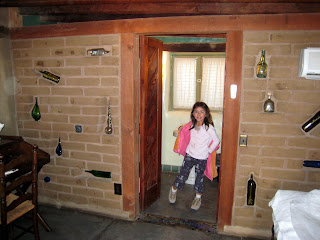 I found this moth-eaten cashmere sweater at Goodwill (a thrift store). It was too nice to trash so I decided to refashion it with an asymmetric scarf collar a la Norah's Cabled Cardigan from the Fall 2006 Issue of Vogue Knitting. Some may recognize the cabled panel as the center panel for the Vortex Street Pullover in Norah Gaughan's book, Knitting Nature.
I found this moth-eaten cashmere sweater at Goodwill (a thrift store). It was too nice to trash so I decided to refashion it with an asymmetric scarf collar a la Norah's Cabled Cardigan from the Fall 2006 Issue of Vogue Knitting. Some may recognize the cabled panel as the center panel for the Vortex Street Pullover in Norah Gaughan's book, Knitting Nature.I plan to cut off the ribbed portions and hem up the bottom and sleeves. Of course, a portion of the center front and the V-neck ribbing will be trimmed away, but I may need to add some clear elastic to stabilize the back neck.
A little bit of darning will be required. I don't have the right color wool and may tea-dye the ecru wools auditioning in the above photograph.
While I was at it, I darned the 20 year old fuchsia wool sweater below, in holey state. I didn't have any wool the right color, so I took one ply of Encore (100% acrylic, sacrilege!) and darned away. You can't tell from a galloping horse.
 I became melancholy while repairing this sweater because my stepmother bought it for me when I was in college. She used to moonlight as a bookkeeper for several Benetton stores. When stuff I might like was about to be marked down, she would sometimes set it aside and buy it with her employee discount.
I became melancholy while repairing this sweater because my stepmother bought it for me when I was in college. She used to moonlight as a bookkeeper for several Benetton stores. When stuff I might like was about to be marked down, she would sometimes set it aside and buy it with her employee discount.It was supposed to be a one day a week job, which it was initially. Math and bookkeeping was not the store owner's forte and he had given her the books in quite a state. After she straightened out the mess she inherited, it took her only 3 hours a month to maintain the books. When the owner found out, he wasn't miffed at all. He told her that she was saving him more than one day a week so she could keep the same pay and leave whenever she was done.
The part that makes me cry is that she was an artist that worked as a bookkeeper. She would get back to her painting "someday", in retirement. Her someday never came. She died of complications of cancer when she was 60.
Aside about Vortex Streets
One of the things I love about my job is walking into lab in the morning to see that morning's satellite overpass. In Los Angeles, the most recent overpass often flew over Guadalupe Island, off the coast of Baja California. When the cloud deck and wind speed and direction are just right, we see a double von Karman vortex street on the lee side of Guadalupe Island.
This image of a vortex street near Guadalupe island (as does the next two after it) comes courtesy of Earth Science World Image Bank. Go visit their site for more images of Vortex Streets.
 Vortex streets form near the Canary islands off the coast of Africa.
Vortex streets form near the Canary islands off the coast of Africa. And near the Kuril islands.
And near the Kuril islands.
NASA's visible earth site also has vortex street imagery.
Don't miss the CIMSS Satellite Blog's entry about vortex streets near Guadalupe island. Follow this link and watch the GOES imagery vortex street video!











































